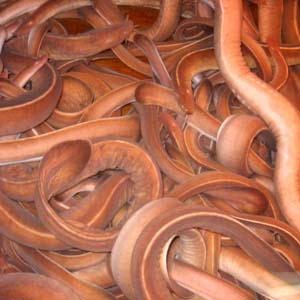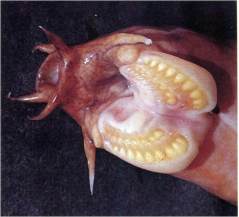by John Bocskay
Beauty is only skin deep, but ugly lives in mud 150 meters under the sea.
I ’ve always loved the Korean word for fish: “mulgogi”, a compound formed from the words “water” (mul) and “meat” (gogi). More than simply labeling a common class of aquatic creatures, “mulgogi” suggests a way of looking at the world, a very East Asian orientation that assumes all things that swim to be edible unless proven otherwise.
Much of Korean seafood strikes the average Westerner as very different, and some of it as downright bizarre: fermented skate, with its powerful ammonia smell; sea cucumbers, whose similarity to an actual cucumber begins and ends with its oblong shape; and live octopus, which is both alive and an octopus. The list goes on, but perhaps no other creature better exemplifies the Korean commitment to sampling the totality of the world’s sea life than the hagfish. Though hagfish are found all over the world and have been known for centuries, they are only eaten in Korea and by the Korean diaspora in Japan and the United States. Even the Chinese – about whom Koreans joke will eat every four-legged thing except the table – lay off the hagfish.
You may have seen them in the tanks at Jagalchi market , these pinkish eel-like creatures the Koreans call ggomjangeo resting in a knotted  mass awaiting the fillet knife. You may have eaten them there, seen them skinned alive, chopped up and thrown still writhing onto a grill with red pepper sauce and onions and served with sesame leaves and garlic. Once you get past the idea of food squirming on the grill, ggomjangeo bokkeum is actually quite tasty. It has a firm, springy texture, and presents some odd shapes as the intestines curl like shirtsleeves, but it ends up tasting more like the same yangnyeom sauce you enjoy with your fried chicken. Some eat it because, like all things vaguely penis-shaped, the hagfish is thought to be a male “stamina food”. Whether you get a rise out of it or not, grilled hagfish is far from the strangest-tasting food you will ever put in your mouth, but considered as an animal, it is arguably one of the biggest oddballs you will encounter on the Korean menu.
mass awaiting the fillet knife. You may have eaten them there, seen them skinned alive, chopped up and thrown still writhing onto a grill with red pepper sauce and onions and served with sesame leaves and garlic. Once you get past the idea of food squirming on the grill, ggomjangeo bokkeum is actually quite tasty. It has a firm, springy texture, and presents some odd shapes as the intestines curl like shirtsleeves, but it ends up tasting more like the same yangnyeom sauce you enjoy with your fried chicken. Some eat it because, like all things vaguely penis-shaped, the hagfish is thought to be a male “stamina food”. Whether you get a rise out of it or not, grilled hagfish is far from the strangest-tasting food you will ever put in your mouth, but considered as an animal, it is arguably one of the biggest oddballs you will encounter on the Korean menu.
Total Weirdo
For starters, the name is misleading. The jangeo part of the name means ‘eel’, though hagfish are not even remotely related to eels and bear only a superficial resemblance to them. The English name hagfish isn’t much better, because as it turns out, they’re not true fish either: they have no jaws, stomach or true fins, and have primitive eyes that sense light but can’t resolve images. Scientists are not even unanimous on whether to classify the hagfish as a vertebrate – an ostensibly unambiguous category – because it is the only known creature to have a bony skull but a spine made entirely of cartilage. The hagfish is so hard to classify that when Carl Linnaeus, the father of modern taxonomy, first encountered one in 1754, he declared it to be a worm, a classification which managed to stand for nearly four decades until it was corrected.
Today we know that the hagfish is an ancient animal – a so-called living fossil that has changed little in over 300 million years and is more closely related to the common ancestor of all vertebrates than it is to any other animal living today except the lamprey (another total weirdo). While scientists continue to debate its place in the evolutionary tree, current opinion strongly suggests that the creature on your dinner plate is a charter member of the proud lineage that gave the animal kingdom its very first spinal column.
Ain’t Got No Alibi
While “fish” may miss the mark, “hag” is not unfair. The hagfish is widely considered to be one of the ugliest animals in the world, because it manages to combine nearly every quality we find repulsive in animals. It looks harmless enough sitting there on the bottom of the tank with its little whiskers (called ‘barbels’) reminiscent of catfish, but just below them, tucked out of sight, is a mouth so creepy that fans of H.R. Giger have wondered whether the retractable mouths of his cinematic aliens were inspired by the hagfish’s ‘rasping tongue‘: four rows of tooth-like “rasps” that project from the mouth (which opens horizontally, by the way), grasps the flesh of its prey and hauls it toward the gullet.
The hagfish’s diet doesn’t win it any admirers either. Once thought to be exclusively a scavenger – another class of animal that no one loves – it is now known to subsist mainly on large, deep-sea worms, a revelation which merely elevated it from a revolting opportunist to a revolting predator. It does scavenge part-time, however: when the carcass of a dead whale or other creature settles on the bottom, thousands of hagfish follow their single nostril to the buffet. Using their rasping tongues, they burrow into the carcass and eat it from the inside out, thus combining the most gag-inducing features of vultures and maggots into one charming package. They’ve also been known to use their unique skill set to infest the bodies of fish trapped in nets, which naturally has done little to endear them to fisherman around the world. Though they certainly chow down like vertebrates, they have the distinctly invertebrate ability to absorb nutrients directly through their skin, which comes in handy when you are literally tucked in to your meal.
“He slimed me”
Despite all that, one of the most remarkable and literally repulsive features of the hagfish is not the way it eats but the way it defends itself from being eaten. If you’ve taken a close look inside a tank full of hagfish, you may have noticed strands of milky filaments swirling around the tank  like old cobwebs. When a hagfish is bitten by a predator (or seized by a middle-aged woman in pink rubber boots) it quickly emits a copious amount of slimy mucus which instantly reacts with water to become a tough, stretchy glob that envelops its body like a cocoon. This slime clogs the gills of would-be predators, who gag on it and spit out the hagfish unharmed thanks to its tough skin (belts, wallets and other accessories are made from it and sold as “eel leather”). Once the danger has passed, the hagfish twists into a knot and slides the knot down the length of its body, whisking off the slime in one motion. This defense strategy is extremely effective; the hagfish has no known aquatic predators because it has evolved over hundreds of millions of years – not to be smarter or faster – but to be chewed on, found repulsive, and spit out intact.
like old cobwebs. When a hagfish is bitten by a predator (or seized by a middle-aged woman in pink rubber boots) it quickly emits a copious amount of slimy mucus which instantly reacts with water to become a tough, stretchy glob that envelops its body like a cocoon. This slime clogs the gills of would-be predators, who gag on it and spit out the hagfish unharmed thanks to its tough skin (belts, wallets and other accessories are made from it and sold as “eel leather”). Once the danger has passed, the hagfish twists into a knot and slides the knot down the length of its body, whisking off the slime in one motion. This defense strategy is extremely effective; the hagfish has no known aquatic predators because it has evolved over hundreds of millions of years – not to be smarter or faster – but to be chewed on, found repulsive, and spit out intact.
The slime has also acted as a turn-off to all but the most determined human diners, and is the source of its genus name Myxine (from the Greek word for slime) as well as its more colorful nicknames slime eel and snot eel. It turns out, however, that hagfish slime is edible. Because it’s composed of protein, it is said to be used as a substitute for egg whites, though I’ve yet to find a restaurant anywhere that uses it. Who knows: maybe with a slightly catchier name and a kickass marketing strategy, hagfish slime omelets could be finding their way to a breakfast menu near you.
 A less far-fetched scenario would be finding a use for it as a fabric. A team of researchers at the University of Guelph, Ontario is looking for ways to replicate the tough, stretchy fibers in hagfish slime and spin it into a renewable fabric that could one day replace non-renewable oil-based fabrics like lycra, spandex, and nylon. They’re not there yet, but hagfish hotpants remain a theoretical possibility.
A less far-fetched scenario would be finding a use for it as a fabric. A team of researchers at the University of Guelph, Ontario is looking for ways to replicate the tough, stretchy fibers in hagfish slime and spin it into a renewable fabric that could one day replace non-renewable oil-based fabrics like lycra, spandex, and nylon. They’re not there yet, but hagfish hotpants remain a theoretical possibility.
There’s still a lot we don’t know about the hagfish, like the size and health of their populations, how they reproduce, how to tell their approximate age, and their precise role in ocean ecosystems. Information like this is critical for managing hagfish fisheries, which are currently unregulated in the United States (which is actually where most of the hagfish in Korea now comes from). If there is a less likely candidate for overfishing than the hagfish I hope I never meet it (or eat it), but it’s worth looking after them all the same. After all, they may be weird, but they’re family.
Author’s Note: October 15th is Hagfish Day, a holiday created by WhaleTimes.org to remind people that even the ugliest creatures need our conservation efforts. Whether you decide that the best way to celebrate Hagfish Day is by eating a hagfish or not eating one is up to you. I won’t judge.



Recent comments